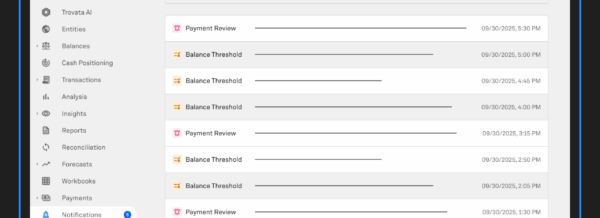For years, treasury teams have relied on Excel to track, categorize, and forecast cash flow. But as businesses scale, so does the complexity of managing financial data. Manually tagging transactions across multiple banking relationships, currencies, and regions is not just tedious—it’s a bottleneck that slows down decision-making and introduces avoidable errors.
In our recent webinar, “Tag, Track, Triumph: Treasurers Share How to Master Your Bank Data,” treasury managers at Lemonade and Gibson Brands shared their journeys firsthand.
Before adopting Trovata, both companies relied on spreadsheets that required daily maintenance to keep financial data organized. Now, with automated transaction tagging, they’ve reclaimed hours of manual work, improved cash visibility, and built a more agile, data-driven treasury operation.
Here’s how they made the leap from spreadsheet chaos to seamless automation.
Excel’s Breaking Point: When Manual Tagging No Longer Scales
Treasury teams often start with Excel-based processes for categorizing transactions. But as transaction volumes grow and reporting needs become more granular, this approach quickly becomes unsustainable.
At Gibson Brands, Treasury Manager Christina Jewel juggled transaction data from 34 bank accounts across 10 countries and in six different currencies—all manually sorted and categorized in spreadsheets:
“We had an abundance of Excel spreadsheets for both domestic and global activities that were manually updated daily. We have multiple banking relationships and had multiple banking platforms to go to daily to download transactional details. I would then manually sort and categorize the transactions and then link these transactions to our Excel reports for balancing. We then used those reports for global forecasting. This was time-consuming and error-prone, so we were thrilled to see Trovata come along.”
For Rob DiTondo, Senior Treasury Manager at Lemonade, the issue wasn’t just manual effort—it was missing crucial insights:
“We were only looking at cash on a ledger balance basis. That meant we were missing out on cash that was either working for us or not. We needed a way to see the full picture in real-time.”
Treasurers need to do more than track cash balances. They need to tell a financial story—why cash is fluctuating, where it’s going, and how it impacts decision-making.
Automated Transaction Tagging: The Game-Changer for Treasury
Instead of manually coding transactions, Trovata automates the process, instantly tagging each line item based on various characteristics from account, bank, transaction type, metadata properties, and even historical patterns. This eliminates the need for daily sorting and manual reconciliation.
At Lemonade, Rob structured transaction tagging to mirror the company’s cash flow story:
“We’re an insurance company. We collect premiums and pay claims. I started bucketing transactions into high-level categories—payments, collections, vendor expenses, inter-company transfers. Now, my list gets smaller and smaller, and I can create reports that tell us exactly why cash is increasing or decreasing.”
The impact? Within three months, Lemonade had automated cash flow tracking across all its entities, providing real-time insights for executive leadership:
“Before, if my CFO asked for our cash burn without marketing expenses, I’d have to go back, clean up data, and pull a new report. Now, I can do it on the spot. The report lives there, updates automatically, and I can pull it up whenever I need it.”
Christina at Gibson Brands had a similar breakthrough:
“Once we got our banking information into Trovata, I created a tagging system organized by our operational regions, and then within each region, we could break it down further into categories, using our existing forecasts and reports as a guide. Trovata now calculates those automatically, and we can group them for totals or drill down into reports for specific totals or even averages.”
Christina’s tip? Create a plan ahead of time for your tags before you start to create them in Trovata.

At Gibson, using Trovata to automate tagging also brought a new level of security and transparency:
“We’ve set up regional users with view-only access, ensuring they get the information they need without altering reports. And with auto-generated reports sent via email, we’ve eliminated manual reporting altogether.”
More Than Time Savings: Unlocking Hidden Insights
The benefits of automated tagging go beyond efficiency—they enable treasury teams to uncover hidden trends and insights that would have been buried in spreadsheets.
Lemonade discovered that certain payment types were skewing reporting:
“JP Morgan’s integration let us break apart ACH batch payments, so now we get line-by-line detail. That helped us identify marketing spend at a granular level—something we couldn’t do before.”
Recommended: Lemonade Builds an Automated Cash Reporting Command Center With Trovata
Tagging is a Strategic Necessity
Automated transaction tagging is more than just a time-saver—it’s the foundation for a modern, strategic treasury operation. It enables:
- Faster decision-making – No more waiting for manual categorization. Data is already structured and report-ready.
- Increased cash visibility – Real-time tracking of balances, inflows, and outflows.
- Accurate forecasting – Machine learning analyzes historical data to predict future cash flow trends. “We use tags as building blocks for all the line items in our forecast. I kind of think of tagging as a foundation for accuracy in managing, grouping, reporting and forecasting your data, the more complex your treasury organization, the more essential tagging structures become.” – Christina Jewel
- Deeper insights – Analyze cash flow trends, identify potential risks, and uncover hidden opportunities.
- Scalability – As businesses grow, transaction volume increases, but tagging rules adjust automatically.
For treasurers like Rob and Christina, the transition from manual to automated transaction tagging wasn’t just an upgrade—it was fundamental for their success.
“Tagging isn’t just a best practice—it’s a strategic necessity,” says Christina. “The more complex your treasury operation, the more essential a strong tagging structure becomes.”
Trovata helps treasury teams move beyond spreadsheets—freeing them to focus on strategic initiatives instead of repetitive tasks.
Ready to Break Free from Manual Tagging?
If your treasury team is still manually categorizing transactions, it’s time to rethink your approach. Trovata automates tagging at scale, delivering real-time insights that empower better financial decisions.
Want to see how it works? Book a demo today and take your treasury operations to the next level.




